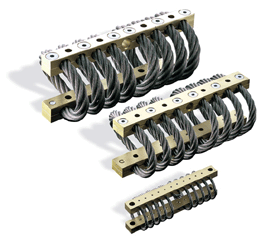There are rigid lines of stainless steel cabling in Enidine wire rope isolators. Anchored to aluminium retaining blocks, the tightly aligned rows of steel sit motionless, yet they simultaneously perform as vibration isolating ropes. Corrosion-resistant and tough as proverbial nails, the wire rope isolators absorb shock and reject oily assaults. In fact, these arcing linkages and their connecting aluminium bars can fight off countless forces, both natural and man-made.
Wire Rope Isolators: High-Performance Attributes
Smaller than other rope-based shock absorbing solutions, Enidine wire rope isolators use twisted stainless steel linkages to dampen vibrations in small spaces. In such cramped spaces, high temperatures are generated, corrosive chemicals drip, and slippery oils coat everything. At least that’s the case in this worst-case scenario. A competitive vibration dampening product might just equalise the vibrational noise, but it still falls short, probably because it can’t withstand the toxic environment. The wire rope isolators described in this post are made from stainless steel and high-grade aluminium, which won’t corrode and won’t ever fail, not when those corrosion-resist alloys are performing at their chemical-resisting best.
A Few Datasheet Parameters
Running a finger down the technical specs list, several series immediately catch the eye. The WR Series features a patented crimp design, plus a reduced number of crimped mounting bars. For the WR2 and WR3 series, loading and deflection characteristics climb higher. The loops of twisted stainless steel increase to fill 25 to 38-mm aluminium blocks or they reduce in number to as few as two loops, which can dampen vibrations in smaller components. A circuit board, for example, mounted on twin linkages of rope isolating steel coils, keeps right on functioning, even when a generator housing is kicking out masses of vibrational energy. In fact, thanks to the crimped coils and mounted block design, Enidine wire rope isolators are quite capable of neutralising several energy forms. Compressible loads are absorbed by the in-series linkages, as are the rolling and shearing forces that impact many noisy machine frames.
It’s a mechatronic age, deep within production lines where robotic arms and electronic circuit boards combine. Unfortunately, those two domains are not compatible, not from a noise-related point of view. Vibrations damage circuit pathways, loosen soldered joints, and compromise anchored fasteners. Acting as a modular spring of sorts, Enidine wire rope isolators adapt. The linkages, the loops of stainless steel, multiply or decrease. Crimped to aluminium bars, those corrosion-proof products bring valuable but sensitive equipment assemblies safely together. The parts attach with the rope isolators, whichever series is selected, performing as designed with their modularly adaptable kinetic properties.
If you would like more information regarding Endine wire rope isolators, click here to read about possible applications and advantages. Alternatively you can download the wire rope isolators catalogue, visit our Endine page or contact us.


